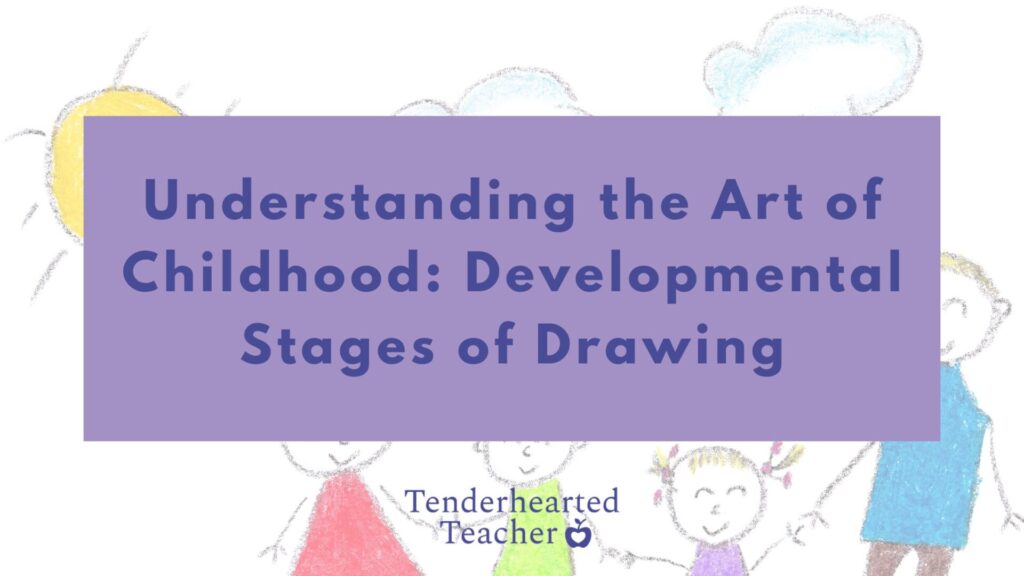
The phrase, “Mama, look what I drew,” is always music to my ears! I love watching my little one create art. Even more, I love hearing him proudly explain his masterpieces to others. This allows me to peek into his mind– not only to see the world how he sees it; but also to get a sense of his cognitive and social-emotional growth. Observing how his artwork becomes more recognizable over time is also fascinating. (The same goes for my students too!) So, today, we’ll examine these awe-inspiring changes– from the initial scribbles, all the way, to realistic representations. Let’s learn more about the developmental stages of drawing in early childhood.
Please note: This post contains affiliate links. As an Amazon Associate, I earn from qualifying purchases. Therefore, if you buy something through these links I will receive a small commission at no extra cost to you. Thank you for your support.
Lowenfeld’s Developmental Stages of Drawing
Viktor Lowenfeld, a renowned Penn State University art professor, is often credited for introducing the developmental stages of drawing to the public with his 1947 book, Creative and Mental Growth. According to education.stateuniversity.com, “This book describes the characteristics of child art at each stage of development and prescribes appropriate types of art media and activities for each age. Its strong psychological orientation provides a scientific basis for creative expression and the practices that cultivate it.”
Lowenfeld’s psychological approach to explaining child art left a lasting impact on the world of education. More current research has since expanded upon his initial work. However, the following stages are still widely considered a framework for understanding children’s artistic development–even decades later. His six stages are broken down like this.
- The Scribble Stage (1-2 years)
- The Pre-Schematic Stage (2-4 years)
- The Schematic Stage (4-7 years)
- Dawning Realism Stage (9-11 years)
- Pseudo-naturalistic Stage (11-13 years)
- The Decision Stage (13+ years)
The Early Childhood Stages
Today, we’ll focus on the first three stages because they generally occur in early childhood. Before we review them, I think it’s important to note that the stages are not an exact science. Instead, they are projected guidelines. Your child’s progression through the stages may differ from the next child based on factors such as exposure and access to art materials and individual fine motor skills. Additionally, children may display characteristics of multiple stages at once.
One of the easiest ways to explore the developmental stages of drawing is by looking at something commonly drawn by young children–the self-portrait. As a preschool teacher, I ask my students to draw self-portraits each marking period. Observing the progression of a child’s self-portrait can provide valuable insights into their cognitive and artistic development over time. Here’s an overview of what they typically include during each of the stages.
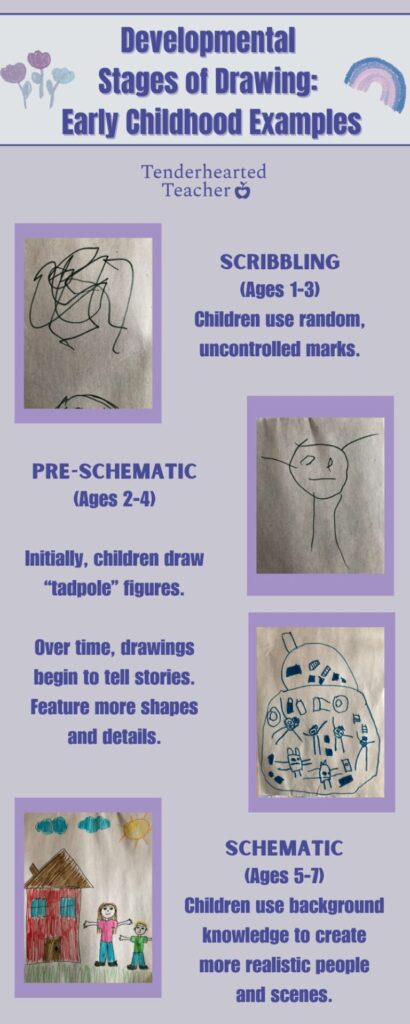
What to Expect in Each Stage
Scribbling (Ages 1-3):
- Features random, uncontrolled marks on the page that don’t have a specific intent or purpose.
- The child may be able to name or describe their scribbles, but the drawings are unrecognizable to others.
Pre-schematic Stage (Ages 3-4):
- The child uses more controlled movements and draws shapes to represent objects or people.
- Initially, a person will resemble a tadpole (a circle with two vertical legs.) Over time, the child will use other basic shapes to create a more recognizable figure. For example, they’ll draw a circle for the head, squares for the body, and dots for facial features. However, the details are inaccurate.
- There’s no rhyme or reason to color choices, space, placement, or proportions. This is subjective based on how the child feels at that particular moment.
Schematic Stage (Ages 5-7):
- This is when a child begins to develop schemas. Simply put, a schema is a child’s basic blueprint for representing objects and people. They develop schemas based on age, social/cultural factors, emotional awareness, and their background knowledge of the world around them. Schemas become more complex and detailed as the child grows and learns new information.
- Self-portraits become more easily identifiable during this stage. Proportions can still be exaggerated but features like the eyes, nose, mouth, and hair are more recognizable. Children may also start to include additional details like clothing and accessories and color choices are more accurate. A child will develop a pattern for creating people and things. They will use these patterns repeatedly to draw multiple figures, i.e. family members and friends.
- They may also begin to create scenes or landscapes–positioning things more appropriately on the page. For example, they’ll have the sun in the sky at the top, grass at the bottom, etc.
Why is Drawing a Self-Portrait Important?
There are so many incredible benefits of art, in general, for young children. You can read about them here. Drawing self-portraits, specifically, promotes several additional benefits. For example, self-portraiture fosters:
1. Self-awareness and Social Awareness
While creating a self-portrait, a child explores their identity through physical appearance, personality traits (likes/dislikes,) and heritage. For example, they may incorporate clothing or accessories that reflect their personal style, interests, and cultural background. Additionally, this exploration of self can lead a child to become more aware of the experiences of others, fostering empathy.
2. Emotional Intelligence
Drawing self-portraits is a wonderful strategy to promote social-emotional learning and a great exercise in self-reflection. A child can use self-portraits as an outlet to express their current emotions and even help them work through past experiences. In addition, drawing can be especially helpful for young children who may not have the vocabulary to explain how they are feeling yet.
3. Confidence and Creativity
Self-portraits foster individuality and creativity as children choose how and what they want to draw. They can explore different techniques, materials, and artistic styles to represent themselves to others. Furthermore, they gain a sense of accomplishment and pride as they reflect on their final product.
4. Cognitive and Fine Motor Development
Drawing, with pencils, markers, and other drawing tools, strengthens a child’s fine motor skills, visual perception, and hand-eye coordination. Additionally, cognition plays a big role in developing schemas. For example, they use recall to make connections to things they’ve seen in the real world–like facial features, emotional expressions, and physical characteristics–to determine what to draw.
5. Assessment of Growth
Finally, as previously mentioned, self-portraits are an excellent tool for observing and recording a child’s cognitive, emotional, and creative development over an extended period.
Strategies to Encourage the Developmental Stages of Drawing
Now that you understand the benefits of drawing, we should review ways to enhance your child’s artistic abilities and self-expression. Here are several simple strategies to encourage the developmental stages of drawing.
- Offer Various Materials: Ideally, you want to provide a physical space (like a table, floor, or easel) for your child to create and explore using various drawing tools and materials. Include crayons, markers, colored pencils, and different types of paper.
- Create a Welcoming Space: Praise their efforts and compliment their creations. Your child should feel encouraged to explore and experiment without the pressure for perfection. Therefore, don’t forget to emphasize the process rather than the final product.
- Make it a Family Affair: Take time to draw together. Model positive behavior as you draw objects from personal experiences, observations of the environment, and your imagination! Here’s a little inspiration from a recent episode of Bluey with the whole family drawing together. Watch a clip from the episode, “Dragon” below.
Conclusion
The developmental stages of drawing represent not only the fascinating growth and development of a child; but also provide a fun and engaging outlet to explore their creativity and imagination. I hope you engage in this rewarding activity with your children to encourage a lifelong love of art exploration. If you found this information helpful, you may also be interested in learning about the emergent writing stages. Click here if you’d like to read more about how children move through them too.
Now talk to me! Share some of your favorite memories about your child’s art below.
SAVE TO PINTEREST
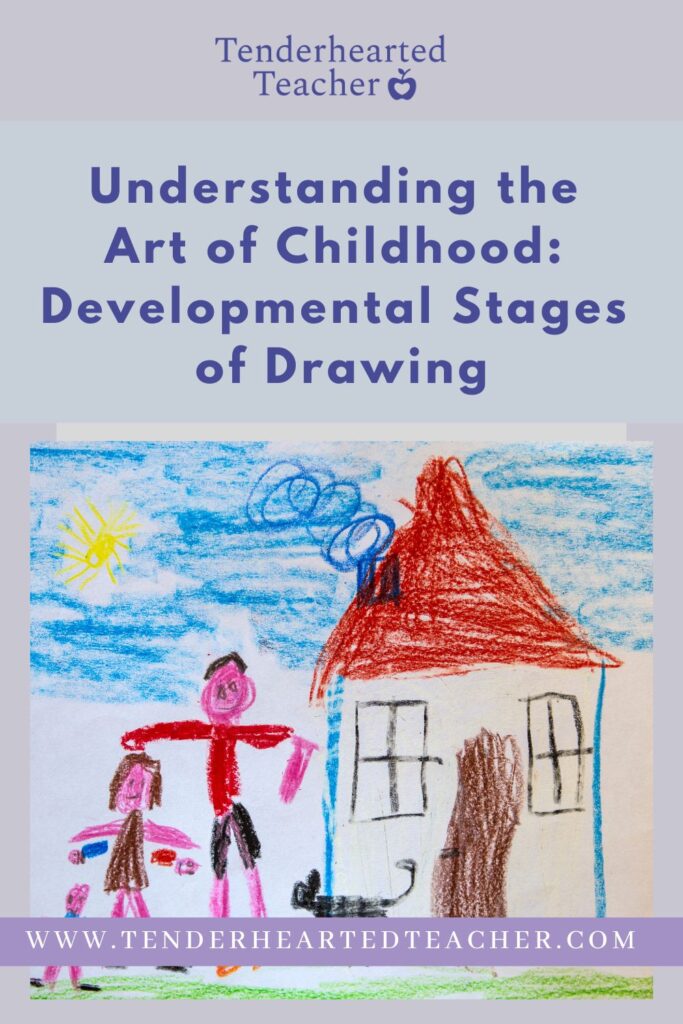
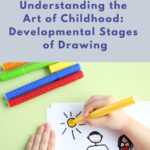
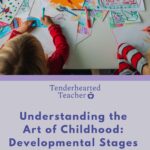
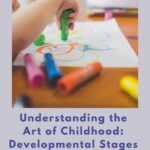
Thank you Sally!
It is really helpful your post. We have seen kids that they are ahead on the drawing stage. It is a fact that the environment is very important to promote not only the drawing skills, but also the sensory explorations and pleasure to do.
Thank you, Veronica! Yes, art provides so many benefits. It’s wonderful to observe a child’s enjoyment and progress.
In a class of schematic students, the teacher gives them an art activity to suit their level, but the teacher notices one student is struggling with the task given, the teacher further notices the student isn’t even well versed in their scribbling. how to role model this activity?
Thanks for your question, Asha. If a child is having difficulty scribbling, it’s most likely because the child hasn’t had enough practice or exposure to drawing and art materials and/or they have immature fine-motor skills. Therefore, I would continue to give them access to different types of paper and writing tools. Try using thick easy-to-grip crayons and chalk which are ideal for young hands. Also, try short golf-sized pencils to encourage a pincer grasp. Also, let them use their fingers to “write/draw” with finger-paint, shaving cream, and sand. And finally allow them to engage in play activities that strengthen their fine-motor skills like pop-beads, playdough, stickers, and tongs. Finally, don’t forget to focus more on their effort and the process of learning, rather than the final product. Over time, their skills will become more refined with practice and encouragement.